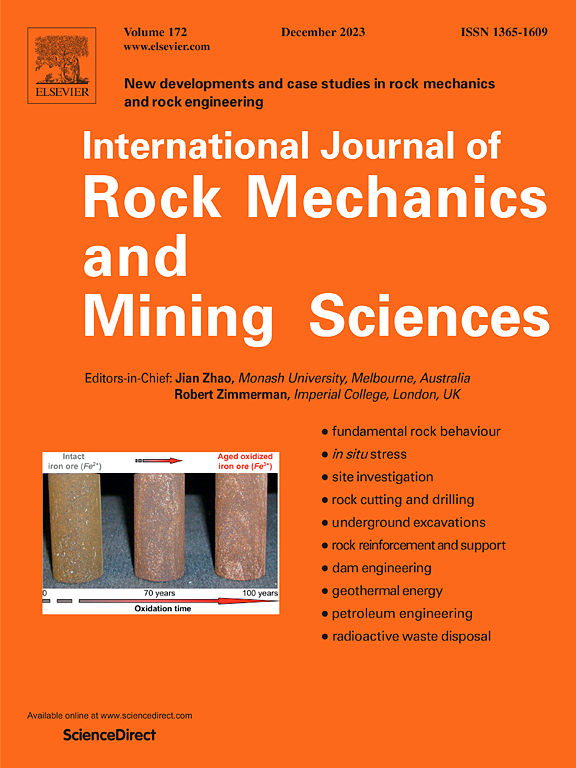The effect of strain rate on inelastic strain development in porous sandstones deformed under reservoir conditions
IF 7
1区 工程技术
Q1 ENGINEERING, GEOLOGICAL
International Journal of Rock Mechanics and Mining Sciences
Pub Date : 2024-11-12
DOI:10.1016/j.ijrmms.2024.105947
引用次数: 0
Abstract
Fluid extraction from sandstone oil, gas, or geothermal reservoirs causes elastic and inelastic compaction of the reservoir, which may lead to surface subsidence and induced seismicity, as observed in the Groningen Gas Field, Netherlands. The inelastic compaction is partly caused by rate- or time-dependent processes, meaning that compaction may continue even if production is stopped. To reliably evaluate the impact of prolonged reservoir exploitation and post-abandonment behavior (10–100 years), mechanism-based rate/time-dependent compaction laws are needed. We systematically investigated the effect of strain rate (rates of – s) in triaxial compression experiments performed on clay-bearing Bleurswiller sandstone (as an analogue of the Groningen reservoir sandstone) and almost clay-free Bentheimer sandstone, to explore the effect of mineralogy. Our results showed a systematic lowering of stress–strain curves with decreasing axial strain rate in Bleurswiller sandstone at differential stresses exceeding 40%–50% of peak stress (i.e. comparable to typical reservoir stress conditions). By contrast, in Bentheimer sandstone, rate effects were only noticeable at differential stresses 70% of peak differential stress. Further investigation of the deformation behavior of Bleurswiller sandstone at varying confining pressure, temperature and pore fluid pH, complemented by microstructural analysis, suggested that the observed rate effects are likely controlled by rate-dependent intergranular frictional sliding at lower differential stress, with an increased role of stress corrosion cracking at higher stress. Extrapolation of our data to reservoir conditions suggests that additional strains of about 10% can be expected, compared to the strain accumulated at laboratory strain rates. Our results show that time-dependent inelastic deformation plays an important role in controlling reservoir deformation, such as of the Groningen gas reservoir. Such effects could lead to an underestimation of surface subsidence and induced seismicity, if not accounted for. The present experiments provide important data for developing physics-based constitutive models for predicting rate/time-dependent reservoir compaction.
应变速率对储层条件下多孔砂岩变形的非弹性应变发展的影响
从砂岩油、气或地热储层中抽取流体会造成储层的弹性和非弹性压实,从而可能导致地表下沉和诱发地震,正如在荷兰格罗宁根气田所观察到的那样。非弹性压实部分是由速率或时间相关过程引起的,这意味着即使停止生产,压实仍可能继续。为了可靠地评估长期储层开采和废弃后行为(10-100 年)的影响,需要基于机理的速率/时间相关压实规律。我们在含粘土的 Bleurswiller 砂岩(作为格罗宁根储层砂岩的类似物)和几乎不含粘土的 Bentheimer 砂岩的三轴压缩实验中系统地研究了应变速率(速率为 10-3-10-9 s-1)的影响,以探索矿物学的影响。我们的研究结果表明,在 Bleurswiller 砂岩中,当差分应力超过峰值应力的 40%-50% 时(即与典型的储层应力条件相当),应力-应变曲线随着轴向应变率的降低而系统性降低。相比之下,在 Bentheimer 砂岩中,只有当压差应力超过峰值压差应力的 70% 时,速率效应才会明显。对 Bleurswiller 砂岩在不同封闭压力、温度和孔隙流体 pH 值条件下的变形行为进行的进一步调查以及微结构分析表明,观察到的速率效应很可能是在较低的压差条件下由速率相关的晶间摩擦滑动控制的,而在较高的压差条件下,应力腐蚀开裂的作用会增强。将我们的数据推断到储层条件表明,与实验室应变速率下累积的应变相比,预计会产生约 10% 的额外应变。我们的研究结果表明,与时间相关的非弹性变形在控制储层变形(如格罗宁根储气库)方面发挥着重要作用。如果不考虑这种影响,可能会导致低估地表下沉和诱发地震。本实验为开发基于物理的构成模型提供了重要数据,用于预测随速率/时间变化的储层压实。
本文章由计算机程序翻译,如有差异,请以英文原文为准。
求助全文
约1分钟内获得全文
求助全文
来源期刊
CiteScore
14.00
自引率
5.60%
发文量
196
审稿时长
18 weeks
期刊介绍:
The International Journal of Rock Mechanics and Mining Sciences focuses on original research, new developments, site measurements, and case studies within the fields of rock mechanics and rock engineering. Serving as an international platform, it showcases high-quality papers addressing rock mechanics and the application of its principles and techniques in mining and civil engineering projects situated on or within rock masses. These projects encompass a wide range, including slopes, open-pit mines, quarries, shafts, tunnels, caverns, underground mines, metro systems, dams, hydro-electric stations, geothermal energy, petroleum engineering, and radioactive waste disposal. The journal welcomes submissions on various topics, with particular interest in theoretical advancements, analytical and numerical methods, rock testing, site investigation, and case studies.

 求助内容:
求助内容: 应助结果提醒方式:
应助结果提醒方式:


